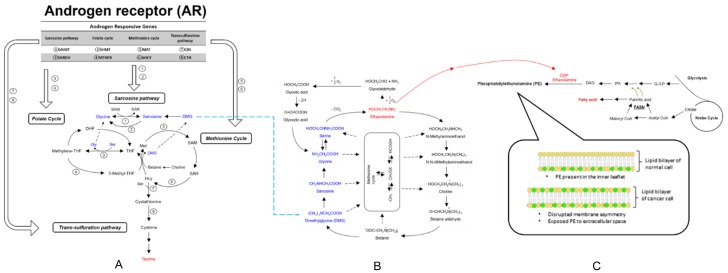Figure 4.
A comprehensive illustration of Androgen signaling, one-carbon metabolism, and metabolic phenotype. (A) One-carbon metabolism involves a complex network with four pathways: (1) folate cycle; (2) methionine cycle; (3) transsulfuration pathway; (4) sarcosine pathway. In the prostate, androgens and the AR regulate the activity/expression of several enzymes involved in the one-carbon metabolism pathway. Enzyme abbreviations are as follows: SARDH: Sarcosine Dehydrogenase; SHMT: Serine hydroxymethyltransferase; GNMT: Glycine-N-methyltransferase; MTHFR: Methylene tetrahydrofolate reductase; MAT: Methionine adenosyltransferase; AHCY: S-adenosylhomocysteine hydrolase; CBS: Cystathionine beta-synthase; CTH: cystathione gamma-lyase or gamma-cystathionase. (B) Hypothetical cycle of metabolism involving glycine, serine, ethanolamine, choline, and betaine. [101] (C) Enhanced lipogenesis, arising from increased activities of fatty acid biosynthetic enzymes (including ACC1, FASN, and stearoyl CoA desaturase (SCD1)), is a metabolic hallmark of many cancer cells. [106-108] In addition, the plasma membrane of normal cells is characterized by an asymmetric distribution of various phospholipids over two membrane leaflet. PE resides in the inner leaflet facing the cytosol. The disrupted membrane asymmetry of cancer cell exposes PE to extracellular space. Furthermore, PE is also highly exposed on endothelium cells in tumor vasculature. PA, phosphatidic acid; PC, phosphatidylcholine; DAG, diacylglycerol; CDP-ethanolamine, Cytidine diphosphate ethanolamine.

